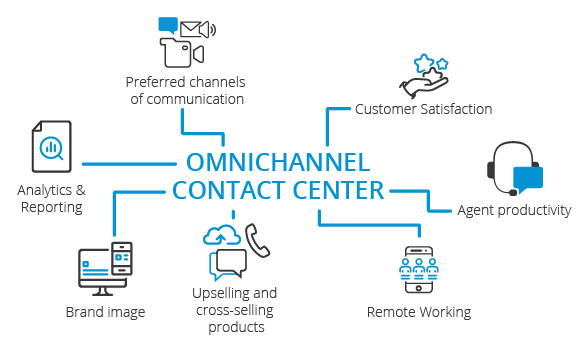Contact centre is a vital part of your business that often doesn’t get the respect or recognition it deserves. While the majority are now accommodating multichannel communication, it still comes with its own limitations and issues. Omnichannel communication, on the other hand, is quickly gaining popularity. But why should you go omni and how do you get there?

What is Multichannel?
Multichannel provides companies a variety of channels to use for customer support and marketing. This typically involves a ticketing system where one agent picks up the task, as it comes through.
What is Wrong with Multichannel?
The issue with multichannel communication is that it remains disintegrated across channels and across the departments. Messages, calls, emails coming in simultaneously often result in customer requests going unnoticed. There’s also a lot of confusion among the agents which is often counterproductive. This can lead to customers receiving inconsistent customer support, as well as the all-familiar dread of having to repeat the same request to multiple agents.
What is Omnichannel?
Omnichannel service is similar to multichannel with the addition of connected and integrated experiences between the communication channels. This ensures consistent customer-focused communication, as well as complete and easy overview of all the incoming requests.
Why You Should Consider Going Omnichannel
“Customers want the easiest experience when they reach out to business and appreciate feeling like they don’t have to explain an issue to multiple people,” prompts Joe C. Hawkins, a marketing blogger at Write my X and 1 Day 2 write. There are some fantastic benefits associated with moving to this system.
Firstly, the research shows that year-to-year customer retention rates are higher for companies using omnichannel, with some reporting a retention 91% greater than those that aren’t. This way, customers can choose the communication method they prefer and don’t have to deal with common frustrations that single or multichannel contact centres typically entail.
In terms of the resolution of customer support, clients can be accommodated faster and feel more valued. An omnichannel system allows you to quickly get back to the customer and assign a qualified specialist to deal with the issue.
The interconnectedness of these channels also offers you a wealth of data on your customer. You can easily track previous conversations, and in case you are ready to take it up a notch – many omnichannel providers also offer CRM integration. It will help to better centralise all of the customer data, as well as give more well-rounded insight into customer behavior. Plus, customers won’t have to repeat the history of their issues and agents will be better prepared to provide the best assistance.
How to Get There
There are two key things to consider when moving to omnichannel. The first is to make sure all the tech you have is robust and up to date. The second is to ensure a list of best practices and make sure all agents are fully trained and able to handle this change.
When it comes to the technology you want to make sure there is a robust customer centred communication solution in place, where:
- Data can be stored that can be accessed by everyone in contact
- A good cloud architecture is available for backup
- User friendly dashboard for easy navigation
- Analytical and automation tools are in place for the most efficient customer support.
“Having the right tech is all well and good but if the staff aren’t well trained and don’t know what best-practice is it’s going to be pointless,” urges business writer Roger Morales of Origin writings and Brit Student.
Take time to train your agents on the system so they know how to use it and set out how you want communication to be handled. Remember consistency is key to making this system work.
Wrapping Up
Overall, it can seem a daunting experience to a company to move from multichannel to omnichannel, but the benefit to the company and customers is well worth it. Taking the time and money to set this up now might actually multiply your profits in the future.


